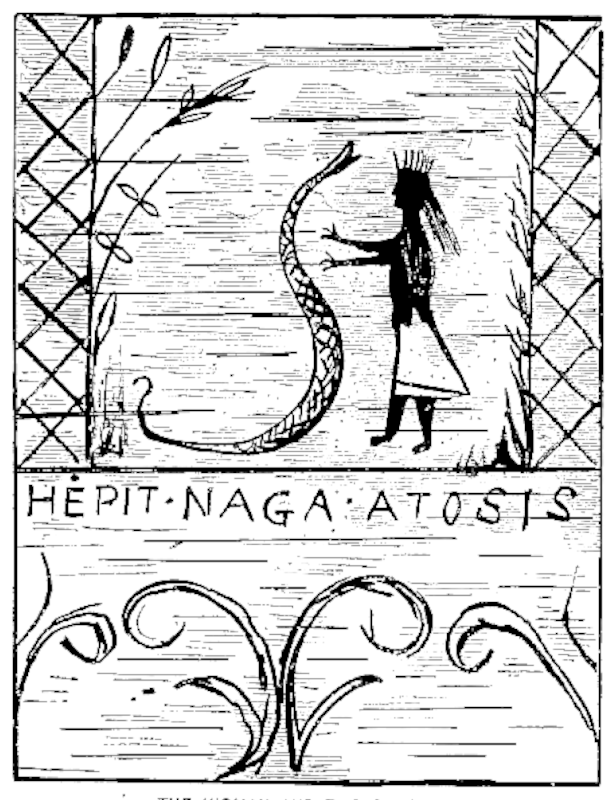| Web
and Book design,
Copyright, Kellscraft Studio 1999-2021 (Return to Web Text-ures) |
Click
Here to return to
The Algonquin Legends of New England Content Page Return to the Previous Chapter |
 (HOME)
|
| Of the Woman who loved a
Serpent who
lived in a Lake. (Passamaquoddy.) Of old times. There was a
very beautiful woman. She turned the heads of all the men. She married,
and her
husband died very soon after, but she immediately took another. Within
a single
year she had five husbands, and these were the cleverest and handsomest
and
bravest in the tribe. And then she married again. This, the sixth, was such a
silent man that he passed for a fool. But he was wiser than people
thought. He
came to believe, by thinking it over, that this woman had some strange
secret.
He resolved to find it out. So he watched her all the time. He kept his
eye on
her by night and by day. It was summer, and she
proposed to go into the woods to pick berries, and to camp there. By
and by,
when they were in the forest, she suggested that he should go on to the
spot
where they intended to remain and build a wigwam. He said that he would
do so.
But he went a little way into the woods and watched her. As soon as she believed that
he was gone, she rose and walked rapidly onwards. He followed her,
unseen. She
went on, till, in a deep, wild place among the rocks, she came to a
pond. She
sat down and sang a song. A great foam, or froth, rose to the surface
of the
water. Then in the foam appeared the tail of a serpent. The creature
was of
immense size. The woman, who had laid aside all her garments, embraced
the
serpent, which twined around her, enveloping all her limbs and body in
his
folds. The husband watched it all. He now understood that, the venom of
the
serpent having entered the woman, she had saved her life by
transferring it to
others, who died. THE WOMAN AND THE SERPENT I do not omit this ghastly
and repulsive legend for the following reasons: One might hastily
conclude,
from its resemblance to the old legend of the origin of the Merovingian
family,
that this idea of the woman with the horrible water spirit for a lover
was of
Canadian French origin. But a story like it in the main detail is told
by the
Indians of Guiana, and that of the Faithless Wife, given in Rink's
Tales and
Traditions of the Eskimo (p. 143), is almost the same. But in the
latter the
husband revenges himself by stuffing the woman full of poisonous
vermin. Rink
says that he had five different versions of this tale, and that one was
from
Labrador, a country often traveled by the Micmacs, and even by the
Penobscots
and Passamaquoddies; I myself knowing one of the latter who has been
there. I
conjecture that this tale sets forth the aboriginal idea of the origin
of a
certain disease supposed to have come from America. It is popularly
believed
among the vulgar that this disease can be transferred to another
person,
thereby removing it from the first. Of this the Rev. Thistleton Dyer,
in his
Folk Lore of Shakespeare, says, "According to an old but erroneous
belief,
infection communicated to another left the infecter free; in allusion
to which
Timon of Athens (Act IV. 3) says, — "'I will not kiss thee; then the rot returns To thy own lips again.'" Bonifacius, Historia
Ludicra, has collected all the instances known to classical antiquity
of women
who had serpent lovers. The kings of the early races of Central America
laid
great stress on the fact that they were descendants of serpents. One
could fill
a volume with all the Arab, Hindoo, and other Oriental tales belonging
to the
beloved of "ophitic monsters." I am indebted for this very
curious and ancient tale to Governor Tomah Josephs, of Peter Dana's
Point,
Maine. |
